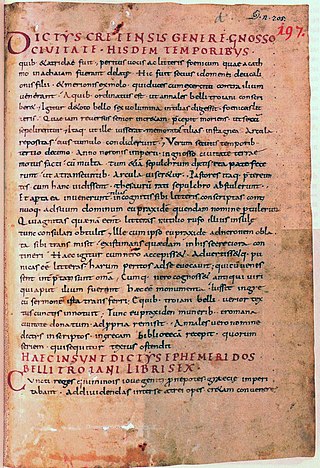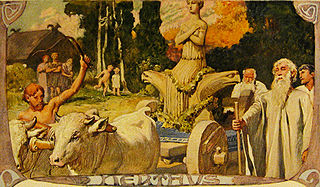
Dictys Cretensis, i.e. Dictys of Crete of Knossos was a legendary companion of Idomeneus during the Trojan War, and the purported author of a diary of its events, that deployed some of the same materials worked up by Homer for the Iliad. The story of his journal, an amusing fiction addressed to a knowledgeable Alexandrian audience, came to be taken literally during Late Antiquity.

In Germanic paganism, Nerthus is a goddess associated with a ceremonial wagon procession. Nerthus is attested by first century A.D. Roman historian Tacitus in his ethnographic work Germania as a "Mother Earth".

The Germania, written by the Roman historian Publius Cornelius Tacitus around 98 AD and originally entitled On the Origin and Situation of the Germans, is a historical and ethnographic work on the Germanic peoples outside the Roman Empire.

The Irish Gospels of St. Gall or Codex Sangallensis 51 is an 8th-century Insular Gospel Book, written either in Ireland or by Irish monks in the Abbey of St. Gall in Switzerland, where it is now in the Abbey library of St. Gallen as MS 51. It has 134 folios. Amongst its eleven illustrated pages are a Crucifixion, a Last Judgement, a Chi Rho monogram page, a carpet page, and Evangelist portraits.

British Library, Add MS 40618 is a late 8th century illuminated Irish Gospel Book with 10th century Anglo-Saxon additions. The manuscript contains a portion of the Gospel of Matthew, the majority of the Gospel of Mark and the entirety of the Gospels of Luke and John. There are three surviving Evangelist portraits, one original and two 10th century replacements, along with 10th century decorated initials. It is catalogued as number 40618 in the Additional manuscripts collection at the British Library.

The Vespasian Psalter is an Anglo-Saxon illuminated psalter decorated in a partly Insular style produced in the second or third quarter of the 8th century. It contains an interlinear gloss in Old English which is the oldest extant English translation of any portion of the Bible. It was produced in southern England, perhaps in St. Augustine's Abbey or Christ Church, Canterbury or Minster-in-Thanet, and is the earliest illuminated manuscript produced in "Southumbria" to survive.
The Agricola is a book by the Roman writer, Tacitus, written c. AD 98. The work recounts the life of his father-in-law Gnaeus Julius Agricola, an eminent Roman general and Governor of Britain from AD 77/78 – 83/84. It also covers the geography and ethnography of ancient Britain.

Lorsch Abbey, otherwise the Imperial Abbey of Lorsch, is a former Imperial abbey in Lorsch, Germany, about 10 km (6.2 mi) east of Worms. It was one of the most important monasteries of the Carolingian Empire. Even in its ruined state, its remains are among the most important pre-Romanesque–Carolingian style buildings in Germany.

British Library, Add MS 11848 is an illuminated Carolingian Latin Gospel Book produced at Tours. It contains the Vulgate translation of the four Gospels written on vellum in Carolingian minuscule with Square and Rustic Capitals and Uncials as display scripts. The manuscript has 219 extant folios which measure approximately 330 by 230 mm. The text is written in area of about 205 by 127 mm. In addition to the text of the Gospels, the manuscript contains the letter of St. Jerome to Pope Damasus and of Eusebius of Caesarea to Carpian, along with the Eusebian canon tables. There are prologues and capitula lists before each Gospel. A table of readings for the year was added, probably between 1675 and 1749, to the end of the volume. This is followed by a list of capitula incipits and a word grid which were added in the Carolingian period.

The Codex Beneventanus is an 8th-century illuminated codex containing a Gospel Book. According to a subscription on folio 239 verso, the manuscript was written by a monk named Lupus for one Ato, who was probably Ato, abbot (736–760) of the monastery of San Vincenzo al Volturno, near Benevento. The unusual odd number of Canon Tables suggests these seven folios were prepared as much as two centuries earlier than the rest of the codex.

The Hilleviones were a Germanic people occupying an island called Scatinavia in the 1st century AD, according to the Roman geographer Pliny the Elder in Naturalis Historia, written circa 77 AD. Pliny's Scatinavia is generally believed to have referred to the Scandinavian peninsula, which in the 1st century AD had not yet been fully explored by the Romans and was therefore described as an island. Pliny wrote that it was an island "of a magnitude as yet unascertained". The Hilleviones lived in the only part of the island that was known, and according to Pliny, they thought of their 500 villages as a separate (alterum) world.

The Schuttern Gospels is an early 9th century illuminated Gospel Book that was produced at Schuttern Abbey in Baden. According to a colophon on folio 206v, the manuscript was written by the deacon Liutharius, at the order of his abbot, Bertricus.

The Ludwigslied is an Old High German (OHG) poem of 59 rhyming couplets, celebrating the victory of the Frankish army, led by Louis III of France, over Danish (Viking) raiders at the Battle of Saucourt-en-Vimeu on 3 August 881.

The La Cava Bible or Codex Cavensis is a 9th-century Latin illuminated Bible, which was produced in Spain, probably in the Kingdom of Asturias during the reign of Alfonso II. The manuscript is preserved at the abbey of La Trinità della Cava, near Cava de' Tirreni in Campania, Italy, and contains 330 vellum folios which measure 320 by 260 mm.

Venetus A is the more common name for the 10th century AD manuscript codex catalogued in the Biblioteca Marciana in Venice as Codex Marcianus Graecus 454, now 822. Its name is Latin for "Venetian A."

The Codex Sangallensis 63, designated by S in some critical editions of the Bible, is a 9th-century Latin manuscript of the New Testament. The text, written on vellum, is a version of the Vulgate and contains the text of the Acts of the Apostles, Epistles, Book of Revelation, and non-biblical material. The manuscript has not survived in a complete condition, some parts of it have been lost. The original manuscript did not contain the Comma Johanneum, but it was added by a later hand on the margin.

The Paenitentiale Theodori is an early medieval penitential handbook based on the judgements of Archbishop Theodore of Canterbury. It exists in multiple versions, the fullest and historically most important of which is the U or Discipulus Umbrensium version, composed (probably) in Northumbria within approximately a decade or two after Theodore's death. Other early though far less popular versions are those known today as the Capitula Dacheriana, the Canones Gregorii, the Canones Basilienses, and the Canones Cottoniani, all of which were compiled before the Paenitentiale Umbrense probably in either Ireland and/or England during or shortly after Theodore's lifetime.

The Frankish Table of Nations is a brief early medieval genealogical text in Latin giving the supposed relationship between thirteen nations descended from three brothers. The nations are the Ostrogoths, Visigoths, Vandals, Gepids, Saxons, Burgundians, Thuringians, Lombards, Bavarians, Romans, Bretons, Franks and Alamanni.
The Codex Hersfeldensis was a manuscript from the Early Middle Ages. Written between 830 and 850, the codex was found in Hersfeld Abbey in the first half of the 15th century. The codex was brought to Italy by Enoch of Ascoli in 1455, where it was divided up and copied. The original has since been lost. The Codex Hersfeldensis is considered to be the original source for the surviving manuscripts of the Opera Minora – the shorter works of Tacitus, including the Germania.
The Codex Heidelbergensis 921 or Codex Palatinus Latinus 921 is a parchment codex dated to the 8th–9th century, containing a copy of the Romana and Getica of Jordanes. It was destroyed in a fire on the night of July 15–16, 1880.

















